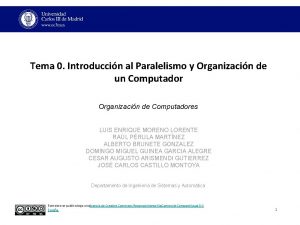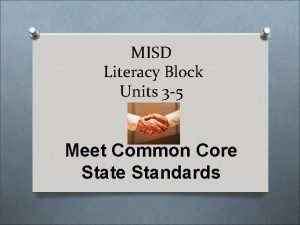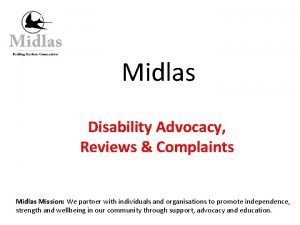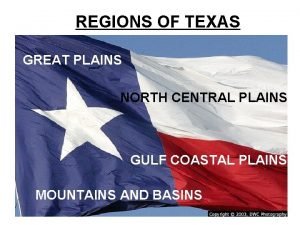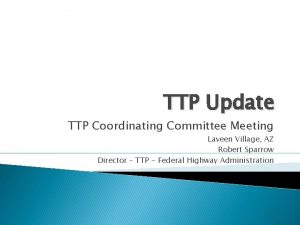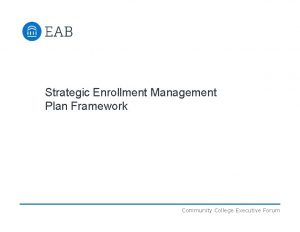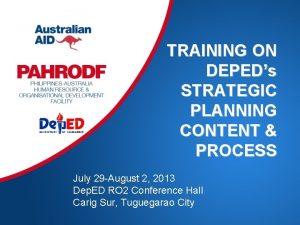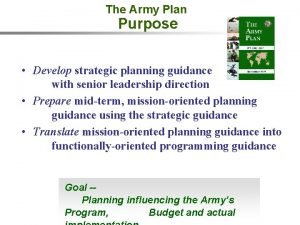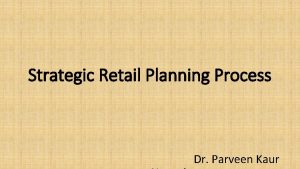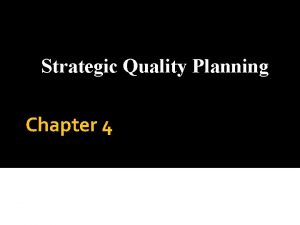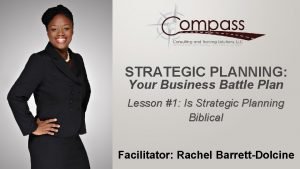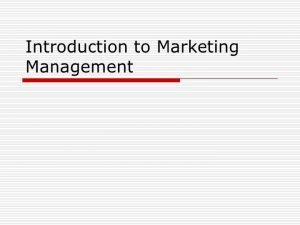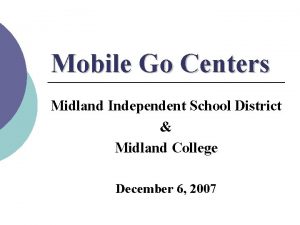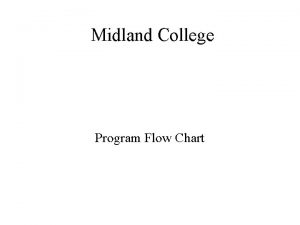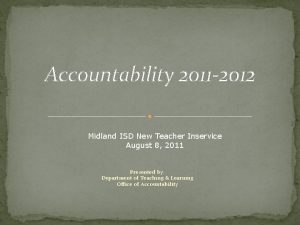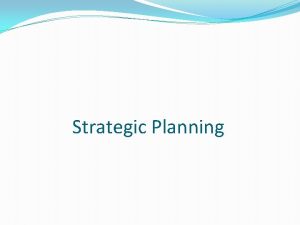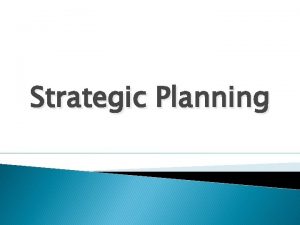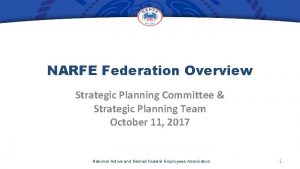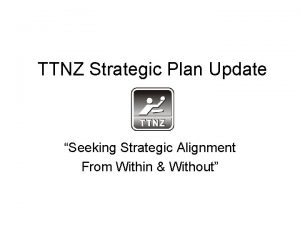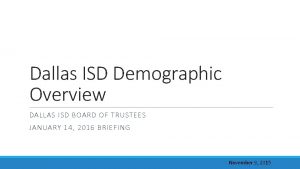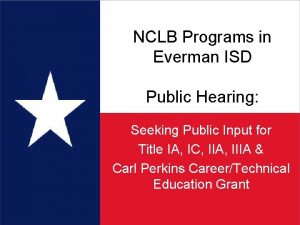Midland ISD MISD Community Strategic Planning Committee Seeking






























- Slides: 30

Midland ISD MISD Community Strategic Planning Committee Seeking solutions to educational facilities for our future

Frequently Asked Questions What is the mission of the Community Strategic Planning Committee? • Find solutions to provide educational facilities for MISD’s future growth. • Take into account program changes apt to occur. • Develop a 10 -year plan and 20 -year vision.

Why do we need a long-range facilities plan? • The school board has the responsibility to anticipate future growth, providing facilities flexible enough to meet changes in programs. • It’s prudent to develop a phased plan for the funding needed expansion. • The CSPC is a community resource offering input for the board’s policy decisions.

What is the District’s growth projection? • Based on current population data, we need to plan for enrollment of 24, 000 by 2018. • Current enrollment (Fall 2008) is about 21, 300. • If enrollments are greater, plans can be adjusted in the out years.

Guiding Principles 1. Address overcrowding and new student growth. 2. Build schools based on programs that address student, district, and community needs. 3. Indentify and build new schools in locations that address growth. 4. Reconfigure grade levels or current building utilization to alleviate overcrowding or to fill buildings not operating at capacity. 5. Upgrade athletic facilities at junior & senior highs.

Goals of the MISD Board of Trustees • Challenge and prepare all students to obtain postsecondary education. • Close the achievement gaps among all student population groups. • Achieve a high degree of parent and community satisfaction. • Meet or exceed the technology standards of the education community. • Achieve a high degree of parent and community satisfaction. • Exercise fiscal responsibility and efficiency.

Who makes up the CSPC? Formed in April 2008, the committee is comprised of 34 invited members. They represent: Parents Business people Educators Former school board members Professional services Real estate Banking City government Chamber of Commerce Nonprofit organizations Young adults Senior citizens All major ethnic groups Education advisors

What has the committee been doing? Since April 2008 it has … • Received comprehensive reports from MISD personnel, and consultant Dr. Arnold Oates • Reviewed six scenarios for school configuration and facilities • Settled on “Scenario 2”= Long Range Facility Plan (LRP) to be achieved as Phase 2 during 2012 -2015 • Been briefed on school finance methods

In the meantime the CSPC recommends … • A Phase 1 enhancement of school facilities, plus the addition of one elementary school. • Phase 2 will involve reconfiguring grade levels: 1. K through 5 th grade; 2. Middle schools for grades 6 , 7 & 8; 3. Senior highs for grades 9 -12. • Later, a Phase 3 will add another elementary school and convert an existing school to an Early Childhood school.

What is the current grade configuration? • Two stand-alone Head Start/Early Childhood Centers; three more on elementary campuses; and one private daycare center • Twenty-three K-6 elementary schools (three with Pre-K programs) • A gifted/talented campus for part time instruction • Four junior highs for grades 7 & 8 • Two freshman high schools for grade 9 • Three senior high schools (MHS, LHS, Coleman)

How is public education changing? • Early Childhood Education (Head Start, Pre-K for 3 & 4 year-olds) • Career and Technology based education • Self-paced learning • State-mandated programs for math & science (4 x 4) • Dual credit courses for up to 36 hours college credit

What are the benefits of early childhood education? A “human capital” investment, meaning • Lower dropout rates • Less teenage pregnancy • Less welfare dependency • A cost-effective means to boost productivity of the workforce 15 to 20 years down the road

Who qualifies for Early Childhood programs? Children 3 to 5 years of age, who … • Come from low-income families • Are English speaking deficient • Are children of active duty military • Are in foster care • Are homeless • Have special needs Within 10 years as many as 2, 000 may qualify

Our Goal Attain the stage of development that enables the child to benefit from the educational experience. In a word, develop Readiness to learn!

Research shows that human capital investments that start in early childhood can have impressive results: Every $1 invested yields $3. 50 in benefits. * * Texas A&M University’s Bush School of Government & Public Service’s Cost-Benefit Analysis of Universally Accessible Pre-K in Texas

Recommended Early Childhood Class Sizes Pupil to adult ratio: • Pre-K through 4 th grade – 22: 1 • Recommended for 3 -year-olds – 16: 2 • Recommended for 4 -5 -year-olds – 20: 2 Source: Texas Education Agency

What grade configurations does the committee prefer? Over a 10+ year period, develop … • Unique Early Childhood schools with Head Start/Prekindergarten programs • Elementary schools for grades K-5 • Middle schools for grades 6 -8 • Senior high schools for grades 9 -12 • Expand size of the alternative high school and programs

Enrollment Projections for 2018 Facilities need to be in place to accommodate an average of: 1, 750 students per grade, K-9 17, 500 1, 500 students per grade, 10 -12 4, 500 2, 000 students in Early Childhood programs (ages 3 & 4) 2, 000 Total Facilities Capacity: 24, 000

What is included in Phase 1? Maintain current grade configuration, 2010 -2012 • Construct new elementary school for 800 • Convert Burnet Elementary to a Head Start/EC school for 500 • Expand Carver to a full day gifted/talented school • Build new infrastructure at MHS & LHS • Expand Coleman High School to 400 students • Establish Early College programs at MC

What is included in Phase 2? Reconfigure grade alignments, 2012 -2015 • Move 9 th grades to senior high campuses • Build 9 th grade centers at MHS & LHS • Convert Crockett Elementary to a Head Start/Pre-K/EC school for 500 • Relocate 6 th grades to middle schools • Convert elementary schools to K-5 • Convert two freshman schools to middle schools

What is included in Phase 3? Add one elementary school and convert one to an EC school, 2015 -2018 • Construct a new elementary school for 800 to replace Emerson Elementary • Convert Emerson Elementary to Head Start/Pre. K/EC for 500 • Add eligible 3 -year-olds to the Early Childhood programs

When and how much will the bond election be? It’s up to the school board, based on … • Input from the CSPC, MISD staff, and the community • November 2009 is a likely date for any or all of the three phases (costs yet to be determined)

When and how much will the bond election be? (cont. ) MISD is one of only 16 districts in the state with an AA rating by Standard & Poors • Last year MISD total valuations were about $9. 3 billion (does not include Greenwood). Values should remain flat this year. • Total bond debt now is approximately $128 million, or 1. 4% of total valuations

When and how much will the bond election be? (cont. ) Current Interest & Sinking fund (I&S) tax for debt service from previous bonds is $0. 125 per $100 valuation. Anticipated New Bond Issue Debt Service: • Each $50 million in bonds approved by taxpayers would add approximately $0. 039 per $100. • Homestead Exemptions are subtracted from the appraised value of a home before calculating the home value to be taxed. • Persons over 65 years of age who have filed for a homestead exemption will not have an increase in the amount they pay. (Tax amount in 2009 will continue the amount due on their homestead).

When and how much will the bond election be? (cont. ) On residential properties the increase for a $50 million bond issue would be: Ø $39 per year for $100, 000 home, or $3. 25 per month Ø $78 per year for $200, 000 home, or $6. 50 per month on Ø $117 per year for $250, 000 home, or $9. 75 per month Multiply the above costs by 2 for $100 million bond issue; by 3 for $150 million, and 4 for $200 million bond issue.

The community has a choice 1. Plan one bond issue to include three phases of facilities additions and enhancements through 2018; or 2. Plan separate bond elections at intervals over the next 10 years (2009 -2019) There advantages and disadvantages to either approach.

Advantages of a “Big Ticket” 1. Save money due to less inflation and construction cost with a six year completion plan for Phase One and Two 2. Have benefit of use of the new facilities at earlier date

Disadvantages of a “Big Ticket” 1. We can’t forecast inflation, construction costs five or ten years out. 2. The political challenges: Midland County bond election last November and Midland Hospital District this May. 3. Slower to address change in educational programs and strategies (more “virtual classrooms” or early college admissions).

Midland ISD Our thanks to our advisors: Advisors to the CSPC Dr. Arnold Oates Dr. Sylvester Perez Wilson Heidelberg Tanya Tinslar James Riggen Jan Lamb

Midland ISD Community Strategic Planning Committee Members Scott Alcorn Doris Anderson Bruce Brady Ken Burgess Brian Carney Donna Cervantes Jurline Cockerham Conrad Coleman Jim Compton Lael Cordes-Pitts Rob Cunningham Joe Dominey Monte Duncan Jay Edwards Pervis Evans Robbyne Hocker Fuller Elva Garza Questions & answers compiled by Joe Dominey Larry Gilbert Hill Glover David Grimes Abraham Gutierrez Iris Hall-Sanders Bill Jackson Ken Marks Bryan Murry Reuben Ramirez Luis Sanchez Tammy Smith Todd Sparks Rachel Stone Carole Symonette Gary Vandergriff Debra Westmoreland Jane Wolf
 Midland dual enrollment
Midland dual enrollment Misd staff links
Misd staff links Canvs misd
Canvs misd Paralelismo funcional
Paralelismo funcional Sisd example
Sisd example Flynn's classification of computer architecture
Flynn's classification of computer architecture Misd
Misd Misd dual credit
Misd dual credit Midlas
Midlas Early college high school at midland college
Early college high school at midland college Mary janousek midland tx
Mary janousek midland tx Gulf coastal plains major cities
Gulf coastal plains major cities Dash landlord accreditation
Dash landlord accreditation Tel tone stock 1929
Tel tone stock 1929 Tel-tone stock 1929
Tel-tone stock 1929 Strategic planning vs tactical planning
Strategic planning vs tactical planning Mipha full form in medical
Mipha full form in medical Laveen village planning committee
Laveen village planning committee Strategic fit vs strategic intent
Strategic fit vs strategic intent Strategic complements example
Strategic complements example Resource based model
Resource based model Analysing the 6 strategic options megxit
Analysing the 6 strategic options megxit Strategic enrollment management plan community college
Strategic enrollment management plan community college Strategic plan example
Strategic plan example Deped strategic planning sample
Deped strategic planning sample The army plan
The army plan Retail planning process
Retail planning process Strategic quality planning process
Strategic quality planning process Is strategic planning biblical
Is strategic planning biblical Strategic planning workshop exercises
Strategic planning workshop exercises Strategic marketing planning process
Strategic marketing planning process



